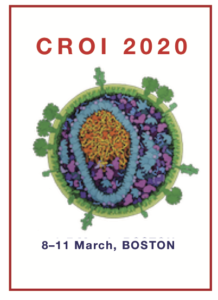Dolutegravir-based ART is safe and effective for pregnant women: first results from the VESTED trial
17 April 2020. Related: Conference reports, Pregnancy, CROI 27 (virtual) 2020.
Fewer women in the DTG + FTC + TAF arm (24.1%) had an adverse pregnancy outcome (composite) than in the DTG + FTC + TDF (32.9%) or EFV + FTC + TDF (32.7%) arms; pairwise comparison p=0.043 and p=0.047 respectively.
Preterm delivery was less frequent with DTG + FTC + TAF (5.8%) than DTG + FTC + TDF (9.4%) or EFV + FTC + TDF (12.1%, p=0.023). Small for gestational age was also less frequent with DTG + FTC + TAF (16.3%) than DTG + FTC + TDF (22.5%) or EFV + FTC + TDF (20.5%) – but none of the by arm comparisons reached statistical significance.
Stillbirth was more frequent with DTG + FTC + TAF (3.7%) and DTG + FTC + TDF (5.2%) than EFV + FTC + TDF (1.9%); all p>0.05 (post-hoc). But neonatal death was more frequent with EFV + FTC + TDF (4.8%) than DTG + FTC + TAF (1.0%) or DTG + FTC + TDF (1.5%,); p=0.019 and p=0.053 respectively .
Overall, 23.0% women and 17.0% infants had one or more grade >3 AE; all p>0.05.
Two infants were diagnosed with HIV at <14 days, one in each of the DTG arms. Maternal delivery viral loads were 58,590 and <40 copies/mL.
Maternal weight gain was significantly higher in the DTG + FTC + TAF arm than the DTG + FTC + TDF arm (p=0.011) or the EFV arm (p<0.001). But this was no greater than the recommended Institute of Medicine weight gain in second/third trimesters (0.42kg/week).
The investigators concluded that all three study regimens led to high rates of viral suppression and DTG-containing regimens had superior virologic efficacy at delivery compared with EFV.
DTG + FTC + TAF was associated with significantly fewer adverse pregnancy outcomes (driven by lower rates of preterm delivery and small for gestational age) and fewer neonatal deaths than EFV + FTC + TDF.
They concluded that these results affirm WHO recommendations to use DTG-based ART in all populations, including pregnant women. They note that TAF might be preferable to TDF in pregnancy.
comment
VESTED is a key ART optimisation study. So these first results from an excellent randomised controlled trial, conducted in a population that will receive WHO-recommended first-line ART, have been greatly anticipated.
The DolPHIN 2 study also showed good virological suppression with DTG-based ART among women starting treatment in pregnancy (late pregnancy – from 28 weeks’ gestation). [2] There were also more still births in this study in the DTG arm. But these were judged not related or unlikely to be related to ART.
The suggestion that TAF might be preferable to TDF in pregnancy needs to be carefully considered against the emerging data showing greater risk of weight gain – also shown in VESTED – with TAF and DTG containing ART. This seems to be more likely among black African women.
Reference
- Chinula L et al. Safety and efficacy of DTG vs EFV and TDF vs TAF in pregnancy: IMPAACT 2010 trial. Oral abstract 130LB.
https://www.croiconference.org/sessions/safety-and-efficacy-dtg-vs-efv-and-tdf-vs-taf-pregnancy-impaact-2010-trial (abstract)
http://www.croiwebcasts.org/p/2020croi/croi/130 (webcast) - Clayden P. Dolutegravir suppresses viral load faster than efavirenz in late pregnancy: results from DolPHIN-2. HTB. 12 March 2019.
https://i-base.info/htb/35794


 Polly Clayden, HIV i-Base
Polly Clayden, HIV i-Base